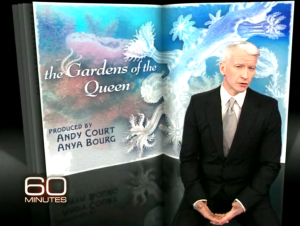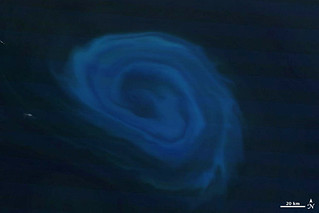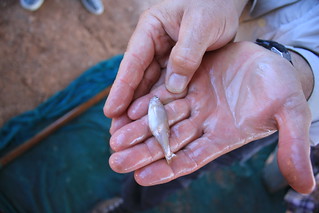RETURN to the Arctic Depths – An Ocean Doctor Special Presentation
In 2007, Greenpeace launched a groundbreaking expedition to explore the two largest underwater canyons in the world, in the heart of the Bering Sea. It was the first time manned […]
In 2007, Greenpeace launched a groundbreaking expedition to explore the two largest underwater canyons in the world, in the heart of the Bering Sea. It was the first time manned […]

60 MINUTES’ “Gardens of the Queen,” with Anderson Cooper named as Finalist in BLUE Ocean Film Festival 2012 (Image: CBS)
The 60 MINUTES presentation of “The Gardens of the Queen” with Anderson Cooper featuring Cuba’s Jardines de la Reina has been named a finalist in the BLUE Ocean Film Festival 2012, to be held September 24-30, 2012 in Monterey, California. Cooper and the 60 MINUTES team joined Dr. David E. Guggenheim, Senior Fellow and Director of the Cuba Marine Research and Conservation Program at The Ocean Foundation and?Fabi?n Pina Amarg’s of the Cuban Center for Coastal Ecosystem Research, to explore this striking underwater ecosystem. Earlier this year, the 60 MINUTES segment, which originally aired in December 2011, won the 2012 Edward R. Murrow Award for excellence in journalism.
“The Gardens of the Queen” will be screened at BLUE, with an introduction and discussion by Dr. Guggenheim, now in his 12th year working in Cuba, along with the 60 MINUTES producers (invited) and panel of experts focused on the significance of the piece as well as the important roles that marine protected areas play in protecting the world’s ocean ecosystems. Read more
Mercury in fish? Much of it comes from the sky. Coal-fired power plants emit tons of the toxic heavy metal into the atmosphere where it travels hundreds of miles before depositing on the surface of lakes, rivers and the oceans, where it is ingested and gradually works its way up to the top of the food chain where it becomes highly-concentrated in the flesh of the ocean’s predators, such as sharks, tunas, and dolphins.
The EPA issued a rule on mercury emissions, but there is now concern that they may weaken the ruling due to push back from electric utility companies. Read more
In a study published in PLos ONE, investigators studied a large die-off of dolphins in the Northern Gulf of Mexico. During the first four months of 2011, 186 bottlenose dolphins, 86 of which were very young perinatal calves, washed ashore from Louisiana to western Florida. For perinatal dolphins, this stranding rate was nearly 6 times higher than the average number of perinatal strandings in the region during the previous 8 years and nearly twice the historical percentage of total strandings. These dolphin deaths represent the largest marine mammal mortality event in the Northern Gulf of Mexico since 2004, when a red tide killed more than 100 bottlenose dolphins off the Florida panhandle.
What killed so many dolphins? Investigators point to a “perfect storm” of dolphins weakened by the BP oil spill, then killed by colder-than-normal water in the Gulf that took its toll on a vulnerable dolphin population. Read more

“The Eddy and the Plankton” A massive plankton bloom observed from space. (Image: NASA Earth Observatory via Flickr)
It’s a controversial idea that has been around for decades. Stimulate the growth of phytoplankton (plant plankton) in remote reaches of the oceans by fertilizing the oceans with iron. Previous studies concluded that such an approach would not be effective. However, the recent analysis of a 2004 ocean fertilization experiment in the Southern Ocean — published in the journal, Nature — shows that use of iron fertilization did stimulate the growth of phytoplankton, which sank into the deep sea after the algae died, serving as a “carbon sink” in the deep where the carbon would be held out of the atmosphere for centuries. Read more
There is great concern about the impacts of plastics on marine wildlife in the Pacific, but much of the focus has been in tropical regions like the Northwestern Hawaiian Islands. A new study in Marine Pollution Bulletin and reported by Discovery News shows that plastics are impacting seabird populations in the Pacific Northwest as well, a region that researchers have compared to the highly-polluted North Sea with respect to plastic pollution.
Read more
We know dolphins are smart, but a study in the Proceedings of the Royal Society A by Timothy Leighton at the University of Southampton, UK, raises the question as to whether dolphins are actually using complex nonlinear math tricks to hunt. Dolphins sometimes create a “bubble curtain” to corral and concentrate prey like sardines, making it easier to pick them off. But dolphins rely on their sonar when hunting, and all those bubbles would seem to interfere with a dolphin’s ability to distinguish its prey. Bubbles certainly interfere with man-made sonar systems. So the researchers wondered if dolphins, which vary the amplitude of their sonar clicks, use a complex nonlinear processing function to essentially separate the noise from the target. In their experiment, they used such mathematical functions to process the echoes of dolphin-like pulses from targets shrouded in bubble clouds. Read more
For 25 years, the Aquarius Reef Base, an undersea laboratory that sleeps six?off of Key Largo, has served as host to numerous marine biologists and NASA astronauts. Even the Ocean Doctor has paid a visit to Aquarius. But after years of declining budgets, the Obama administration has eliminated the base’s funding, and the world’s last remaining undersea lab is faced with decommissioning — or finding its own funding. NPR reports that Dr. Sylvia Earle and other researchers are now conducting a mission of outreach and education in Aquarius to help save it.
The Environmental News Network (ENN) reports that a federal judge has approved an $880 million plan to restore the Everglades, a decision that could result in the settlement of numerous lawsuits spanning 25 years. In addition, U.S. Agriculture Secretary Tom Vilsack visited Kissimmee, Florida to announce an infusino of an additional $80 million from the federal government to support farmers and ranchers who voluntarily conserve wetlands on agricultural land in the northern portion of the Everglades Ecosystem. Read more

Exposure to Bisphenol A (BPA) from plastic pollution could accelerate interbreeding of native species with exotic species, like the red shiner (pictured). (Image by TimeScience via Flickr)
An article in Evolutionary Applications raises concerns about the impacts of plastics in aquatic environments. It has already been well-documented that Bisphenol A (BPA) affects animal development and behavior because it mimics the hormone estrogen. Consequences can include impairing the ability of males to produce offspring. New Scientist reports that the new study, led by Jessica Ward of the University of Minnesota in Saint Paul, demonstrates effects that have further consequences with serious implications for biodiversity.
Fish exposed to BPA were more likely than the unexposed fish to approach fish of the other species and court them.
Red shiners are an invasive species, often introduced to new areas by fishermen who use them as bait. They often hybridise with native species, and exposure to oestrogen-mimicking chemicals like BPA could make it even more likely that they would do so.
Although it has a lower profile than habitat loss and overhunting, interbreeding is a big threat to biodiversity. “Hybridisation is one of the most common and widespread causes of species loss, especially in fish,” Ward says.
…More at Plastic ingredient makes fish court other species (New Scientist)
The U.S. Food and Drug Administration rejected calls to ban BPA from all plastic food containers earlier this year.
Just Released: The Remarkable Reefs of Cuba: Stories of Hope from the Ocean Doctor by Dr. David E. Guggenheim, President of Ocean Doctor
